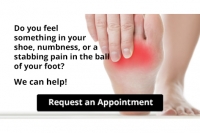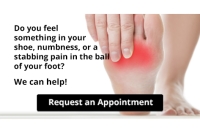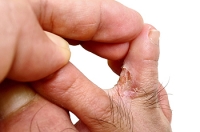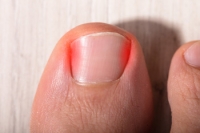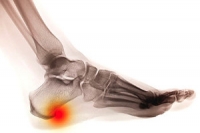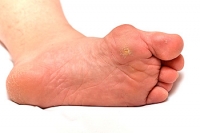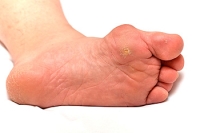
Blog (807)
Why Live with Pain and Numbness in Your Feet?
Why Live with Pain and Numbness in Your Feet?
Friction Causes Corns
Corns can form on the tops or sides of the toes. They develop as a result of friction that can be caused by wearing shoes or socks that do not fit correctly. The noticeable symptoms often consist of pain and tenderness in the affected area, and it may be difficult to wear constricting shoes. Wearing larger shoes may prevent excess friction, so this may be a successful method in preventing corns from developing. For corns that are newly formed, patients may find mild relief after soaking their feet in warm water, followed by moisturizing the area where the corn is. This may help to soften the corn, and then a pumice stone may be an effective method in gradually diminishing it. For more severe corns, it is suggested to consult with a podiatrist who is able to perform different forms of treatment.
Corns can make walking very painful and should be treated immediately. If you have questions regarding your feet and ankles, contact Dr. Kenneth Donovan of Advanced Care Foot and Ankle. Our doctor will treat your foot and ankle needs.
Corns: What Are They? And How Do You Get Rid of Them?
Corns are thickened areas on the skin that can become painful. They are caused by excessive pressure and friction on the skin. Corns press into the deeper layers of the skin and are usually round in shape.
Ways to Prevent Corns
There are many ways to get rid of painful corns such as:
- Wearing properly fitting shoes that have been measured by a professional
- Wearing shoes that are not sharply pointed or have high heels
- Wearing only shoes that offer support
Treating Corns
Although most corns slowly disappear when the friction or pressure stops, this isn’t always the case. Consult with your podiatrist to determine the best treatment option for your case of corns.
If you have any questions please feel free to contact one of our offices located in Warren, Livingston, and Toms River, NJ . We offer the newest diagnostic and treatment technologies for all your foot and ankle needs.
Possible Treatment of Ingrown Toenails
The medical name for an ingrown toenail is referred to as onychocryptosis. It is a painful condition of the big toe, and it occurs as the sides of the nail grow into the surrounding skin. The symptoms that are associated with this ailment often consist of severe pain and swelling, in addition to becoming red and inflamed. There are several reasons why ingrown toenails may develop. These can include wearing shoes that do not have adequate room for the toes to move freely in, trimming the toenails incorrectly, or if an injury has occurred to the nail. Treatment techniques may consist of splinting the nail, as this may help to protect the skin surrounding the affected nail. Additionally, if the ingrown toenail becomes infected, surgery may be an option to consider. If you have developed this condition, it is advised to seek the counsel of a podiatrist who can properly diagnosis and treat this ailment.
Ingrown toenails can become painful if they are not treated properly. For more information about ingrown toenails, contact Dr. Kenneth Donovan of Advanced Care Foot and Ankle. Our doctor can provide the care you need to keep you pain-free and on your feet.
Ingrown Toenails
Ingrown toenails occur when a toenail grows sideways into the bed of the nail, causing pain, swelling, and possibly infection.
Causes
- Bacterial infections
- Improper nail cutting such as cutting it too short or not straight across
- Trauma to the toe, such as stubbing, which causes the nail to grow back irregularly
- Ill-fitting shoes that bunch the toes too close together
- Genetic predisposition
Prevention
Because ingrown toenails are not something found outside of shoe-wearing cultures, going barefoot as often as possible will decrease the likeliness of developing ingrown toenails. Wearing proper fitting shoes and using proper cutting techniques will also help decrease your risk of developing ingrown toenails.
Treatment
Ingrown toenails are a very treatable foot condition. In minor cases, soaking the affected area in salt or antibacterial soaps will not only help with the ingrown nail itself, but also help prevent any infections from occurring. In more severe cases, surgery is an option. In either case, speaking to your podiatrist about this condition will help you get a better understanding of specific treatment options that are right for you.
If you have any questions please feel free to contact one of our offices located in Warren, Livingston, and Toms River, NJ. We offer the newest diagnostic and treatment technologies for all your foot and ankle needs.
What Are Heel Spurs?
A heel spur is a foot condition that is caused by a calcium deposit that extends between your heel bone and arch. They often start in the front of the heel and eventually begin to affect other parts of the foot. Heel spurs can be caused by repetitive stress from walking or running, bruising of the heel, poorly fitted and worn-out shoes, walking gait issues and arthritis. Symptoms can include pain, inflammation and swelling at the front of the heel. Symptoms only show up in about 50 percent of people with heel spurs. Because of this, the majority of heel spurs are discovered through X-rays and other tests done for foot ailments. In order to prevent heel spurs, it is important to be aware of your overall foot health and what your feet go through on a daily basis. You should get your foot checked out as soon as you feel pain, as well as ceasing any physical activity until the pain subsides. If you are experiencing foot or heel pain, it is advised that you see a podiatrist for their opinion.
Heel spurs can be incredibly painful and sometimes may make you unable to participate in physical activities. To get medical care for your heel spurs, contact Dr. Kenneth Donovan from Advanced Care Foot and Ankle. Our doctor will do everything possible to treat your condition.
Heels Spurs
Heel spurs are formed by calcium deposits on the back of the foot where the heel is. This can also be caused by small fragments of bone breaking off one section of the foot, attaching onto the back of the foot. Heel spurs can also be bone growth on the back of the foot and may grow in the direction of the arch of the foot.
Older individuals usually suffer from heel spurs and pain sometimes intensifies with age. One of the main condition's spurs are related to is plantar fasciitis.
Pain
The pain associated with spurs is often because of weight placed on the feet. When someone is walking, their entire weight is concentrated on the feet. Bone spurs then have the tendency to affect other bones and tissues around the foot. As the pain continues, the feet will become tender and sensitive over time.
Treatments
There are many ways to treat heel spurs. If one is suffering from heel spurs in conjunction with pain, there are several methods for healing. Medication, surgery, and herbal care are some options.
If you have any questions feel free to contact one of our offices located in Warren, Livingston, and Toms River, NJ. We offer the latest in diagnostic and treatment technology to meet your needs.
Are You Suffering From Ingrown Toenails?
Plantar Warts Can Be Treated!
Plantar Warts Can Be Treated!
What Causes a Bunion to Develop?
If you notice a bony protrusion at the base of your big toe, you may have a bunion. A bunion is considered to be a bone deformity and may develop for specific reasons. These reasons can include certain genetic factors. The disorder causes the big toe to move toward the toe next to it, and the joint will gradually extend outward. There are additional reasons why bunions may form, which can include forms of arthritis, low arches, or foot injuries. The symptoms that are often associated with this condition are pain and discomfort on and near the affected area, swelling, numbness, and a burning sensation. Mild relief may be found when proper shoes are worn and when ceasing any activity that causes pain. If you have a bunion, it is suggested that you seek the counsel of a podiatrist who can treat this condition.
If you are suffering from bunions, contact Dr. Kenneth Donovan of Advanced Care Foot and Ankle. Our doctor can provide the care you need to keep you pain-free and on your feet.
What Is a Bunion?
A bunion is formed of swollen tissue or an enlargement of boney growth, usually located at the base joint of the toe that connects to the foot. The swelling occurs due to the bones in the big toe shifting inward, which impacts the other toes of the foot. This causes the area around the base of the big toe to become inflamed and painful.
Why Do Bunions Form?
Genetics – Susceptibility to bunions are often hereditary
Stress on the feet – Poorly fitted and uncomfortable footwear that places stress on feet, such as heels, can worsen existing bunions
How Are Bunions Diagnosed?
Doctors often perform two tests – blood tests and x-rays – when trying to diagnose bunions, especially in the early stages of development. Blood tests help determine if the foot pain is being caused by something else, such as arthritis, while x-rays provide a clear picture of your bone structure to your doctor.
How Are Bunions Treated?
- Refrain from wearing heels or similar shoes that cause discomfort
- Select wider shoes that can provide more comfort and reduce pain
- Anti-inflammatory and pain management drugs
- Orthotics or foot inserts
- Surgery
If you have any questions, please feel free to contact one of our offices located in Warren, Livingston, and Toms River, NJ . We offer the newest diagnostic and treatment technologies for all your foot care needs.
What Causes a Bunion to Develop?
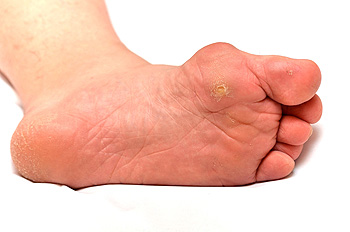 If you notice a bony protrusion at the base of your big toe, you may have a bunion. A bunion is considered to be a bone deformity and may develop for specific reasons. These reasons can include certain genetic factors. The disorder causes the big toe to move toward the toe next to it, and the joint will gradually extend outward. There are additional reasons why bunions may form, which can include forms of arthritis, low arches, or foot injuries. The symptoms that are often associated with this condition are pain and discomfort on and near the affected area, swelling, numbness, and a burning sensation. Mild relief may be found when proper shoes are worn and when ceasing any activity that causes pain. If you have a bunion, it is suggested that you seek the counsel of a podiatrist who can treat this condition.
If you notice a bony protrusion at the base of your big toe, you may have a bunion. A bunion is considered to be a bone deformity and may develop for specific reasons. These reasons can include certain genetic factors. The disorder causes the big toe to move toward the toe next to it, and the joint will gradually extend outward. There are additional reasons why bunions may form, which can include forms of arthritis, low arches, or foot injuries. The symptoms that are often associated with this condition are pain and discomfort on and near the affected area, swelling, numbness, and a burning sensation. Mild relief may be found when proper shoes are worn and when ceasing any activity that causes pain. If you have a bunion, it is suggested that you seek the counsel of a podiatrist who can treat this condition.
If you are suffering from bunions, contact Dr. Kenneth Donovan of Advanced Care Foot and Ankle. Our doctor can provide the care you need to keep you pain-free and on your feet.
What Is a Bunion?
A bunion is formed of swollen tissue or an enlargement of boney growth, usually located at the base joint of the toe that connects to the foot. The swelling occurs due to the bones in the big toe shifting inward, which impacts the other toes of the foot. This causes the area around the base of the big toe to become inflamed and painful.
Why Do Bunions Form?
Genetics – Susceptibility to bunions are often hereditary
Stress on the feet – Poorly fitted and uncomfortable footwear that places stress on feet, such as heels, can worsen existing bunions
How Are Bunions Diagnosed?
Doctors often perform two tests – blood tests and x-rays – when trying to diagnose bunions, especially in the early stages of development. Blood tests help determine if the foot pain is being caused by something else, such as arthritis, while x-rays provide a clear picture of your bone structure to your doctor.
How Are Bunions Treated?
- Refrain from wearing heels or similar shoes that cause discomfort
- Select wider shoes that can provide more comfort and reduce pain
- Anti-inflammatory and pain management drugs
- Orthotics or foot inserts
- Surgery
If you have any questions, please feel free to contact one of our offices located in Warren, Livingston, and Toms River, NJ . We offer the newest diagnostic and treatment technologies for all your foot care needs.
